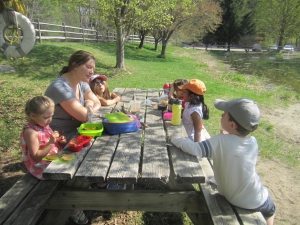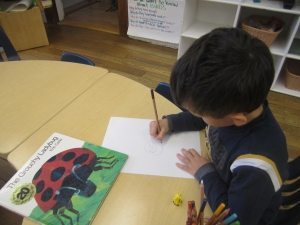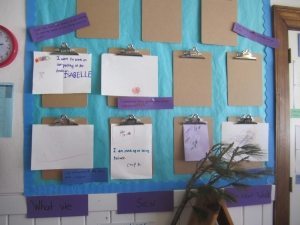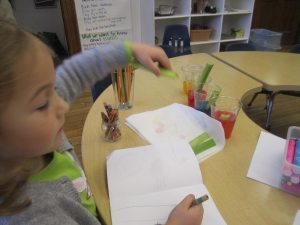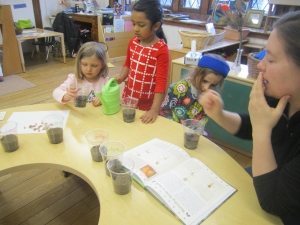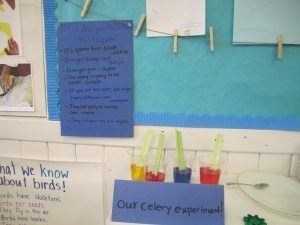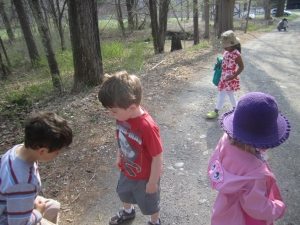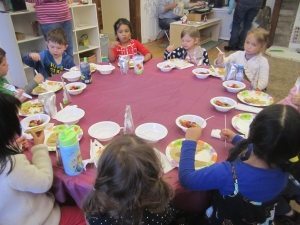Thank you, parents, for nurturing and nourishing us during Teacher Appreciation Week. We did feel appreciated, and loved. Your sweet gestures, the flowers, and the special breakfast and meals were all beautifully presented, heartwarming and delicious.
We apologize for being off the grid for a couple of weeks (due to computer issues at home.) Much has gone on! We are well into our investigations into the signs of spring, trees, our seeds, and literature; we are building our growing “feelings” vocabulary to understand ourselves and others better; and we are continuing our relationship building with others in our BCD community.
Encouraging children to question is a way to nourish their curious minds. In traditional teacher-centered learning a teacher tells students what something is and what will happen. Teachers ask the questions which students answer. In student-centered learning students discover for themselves by hypothesizing, opening their minds to possibilities, and observing and analyzing outcomes. At BCD we encourage students’ questions. We model question strategies and provide the structure for their inquiring minds to grow. Nurturing these habits in preschool helps to build the foundation for lifetime learning.
Your children asked lots of questions in the past weeks, mostly relating to our investigations of seeds and how plants grow. We have prepared the soil, observed, discussed, hypothesized and planted our bean seeds, and observed and charted their growth. We revisited our KWL (what we know, what we want to know and what we have learned.) about seeds, trees, flowers and birds. This has given structure to our thinking and has provided opportunities for questioning and further investigation. In learning about the parts of a plant and how they are nourished and grow we began with roots. We conducted a celery experiment, placing a stalk of celery in a glass of water with red food coloring. We observed beans sprout roots in paper towels, too, and we split flower stems to see their insides. We have pressed flowers and examined bird nests, too.
Your children had many questions and hypotheses relating to what might happen and why, and have loved checking the celery and repeating the experiment. It was exciting to see that many of their predictions were right. This led to further discussions about roots, stems of plants and trunks of trees, including an investigation (under a magnifying glass) of tree rings. This kind of careful observation is another mindful habit we are working on.
Over the last 6 weeks during our nature walks each child has chosen something to pay particular attention to – green leaves, animals tracks, flowers, nests, and so on. They are observing how things change over time. They also bring things inside to observe more closely. They write their observations from their walks in their science journals. Some write a question they have. Many bring things inside, such as a flower or a leaf, to sketch in their journals. They are learning how things change over time, how weather affects growing, and how to observe things closely. They are also learning to record their observations and to collect data.
Everything your children do is interrelated. Science studies involve writing and communicating, math (counting, comparing, subtracting,) art and social skills. Being outside and learning in nature is a natural mood enhancer, as well, and we have happy, engaged and curious children!
Reading for information is less student-centered, but is also a powerful way for children to learn about their world. Our stories about seeds and plants help children to build on their knowledge. One of these, Oh, Say Can You Seed? is part of the Cat in the Hat series, telling the story of plant growth with whimsical rhythms and rhymes. Rhyming stories also develop phonetic awareness, a pre-reading skill.
We read for information and for guidance as we explore nature. Every day we read about trees, plants, spring, animals and the weather. Our latest book The Listening Walk is showing us how to observe sounds as we take our walks outside. This past week CJ shared The Lorax by Dr. Seuss which helps build empathy for our earth by showing us the consequences of our actions (all while being entertaining and filled with whimsical rhymes!) This led your children to want to make Lorax style creations. What fun!
Reading opens our minds to multiple perspectives, gives voice to feelings, helps us to sequence events and understand concepts. Our investigation of Eric Carle’s books have done that and so much more for us! Little Cloud is about transformative thinking, going from what moving clouds become (a sheep? an airplane?) to what clouds really do (make rain.) The Grouchy Ladybug
and The Very Clumsy Click Beetle
led us to discussions about feelings and a time we were grouchy or something we are clumsy about and want to improve. Mr. Seahorse helped us understand that there are unexpected, different roles that family members play. Pancakes, Pancakes! helped us sequence all the steps needed to gather the ingredients and prepare pancakes. All of Carle’s illustrations are happy, whimsical and inviting. His books have helped us learn, reflect and just plain feel good! We took a wonderful excursion to the Mahaiwe Performing Arts Center to see some of the Carle stories we have read come to life. The performances were yet another way to experience these timeless tales through different lenses. Thank you, Jenny, Noelle’s mom and Amanda, Abigail’s, mom, for helping out on this trip. Coincidentally, Derek, Noel’s dad, made us pancakes, eggs and fruit salad for a Breakfast for Lunch treat!
In addition to questions and literature, this post is also about relationships, another key component to our PreK classroom. We continue to strengthen our connections to our 9th grade lunch buddies and our 3rd grade reading buddies. One of the many things these buddies do is to model caring and helpful behavior. This has served our children well, as they, in turn, have been caring and helpful to our many visitors. We also enjoyed the sense of community at some all-school assemblies – one with YoYo Man! and another from Berkshire Theatre Group. And we realize that others care enough to do thoughtful things for us such as Sonya’s mom bringing in yummy cookies. Giving back we worked on a school-wide video project for the auction, as well. Each child came up with 3 words to describe his/her experience at BCD.
We also learned more of the world around us in the Berkshires and enjoyed a lovely excursion to Hancock Shaker Village where we met farm animals. We were able to pet and hold them, and also went to the hands-on discovery area for crafts. Thank you to the following parents who helped out on this trip: Aidan’s dad Geoff, CJ’s mom Natalie, Noelle’s dad Derek, and Nicolette’s dad Chris.
Another important part of relationship building is in developing confidence. One of the ways we do this is with our Star of the Week. Our recent stars have been Aidan, Nicolette, Neha and CJ. We love the everyday toys, books, dolls and games that the children bring in to share. These have special meaning and help your children practice speaking to a group. Aidan shared a toy truck, a video of when he was small, a toy his nanny made for him and stickers from his lego book. He also shared his dad who read some stories to us! Nicolette share some special toys and dolls. Neha shared some wonderful family photos and a book. CJ shared some wonderful books, a fire bird he made, and some other toys.
For those of you viewing this blog on your iphone or ipad, you can view the pictures here: https://www.flickr.com/photos/bcdtech/sets/72157650694710455/
https://www.flickr.com/photos/bcdtech/sets/72157650682025501/

